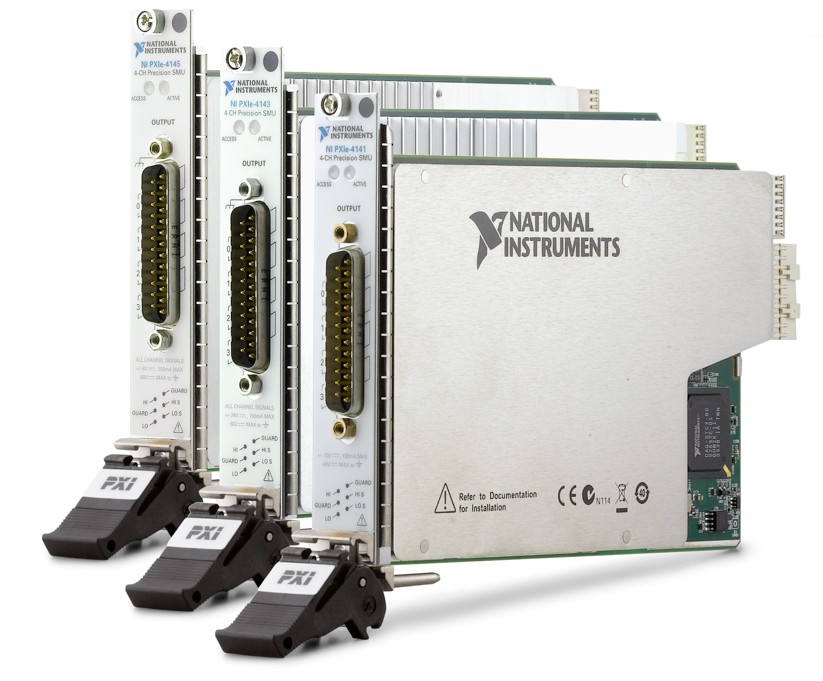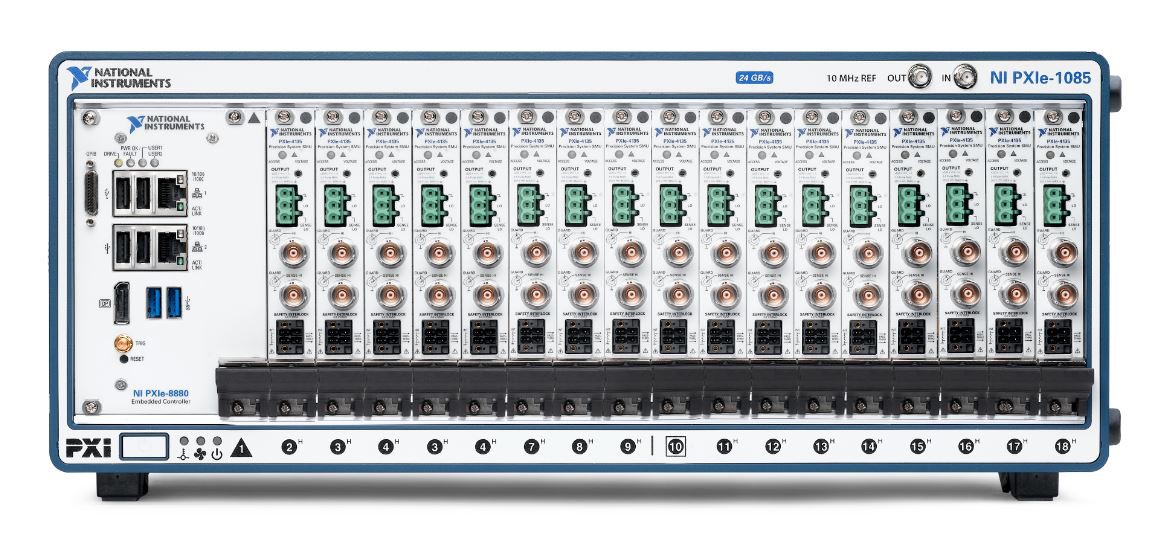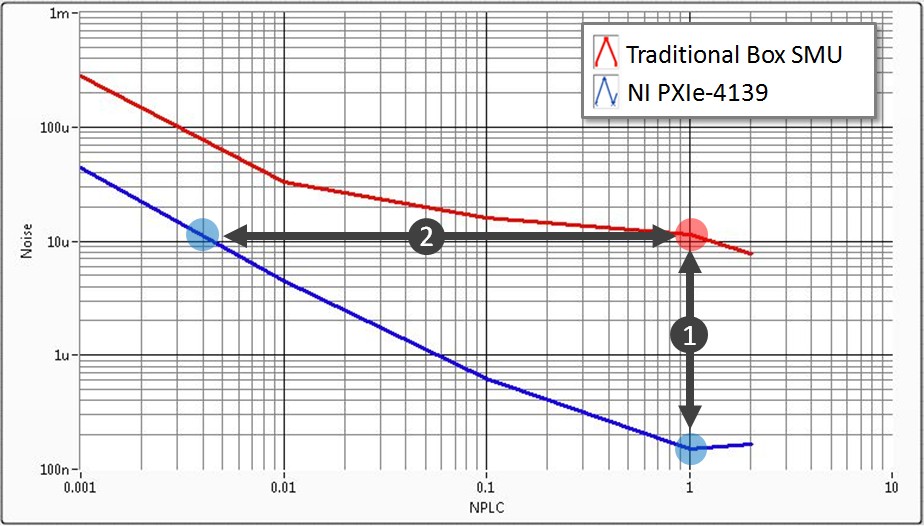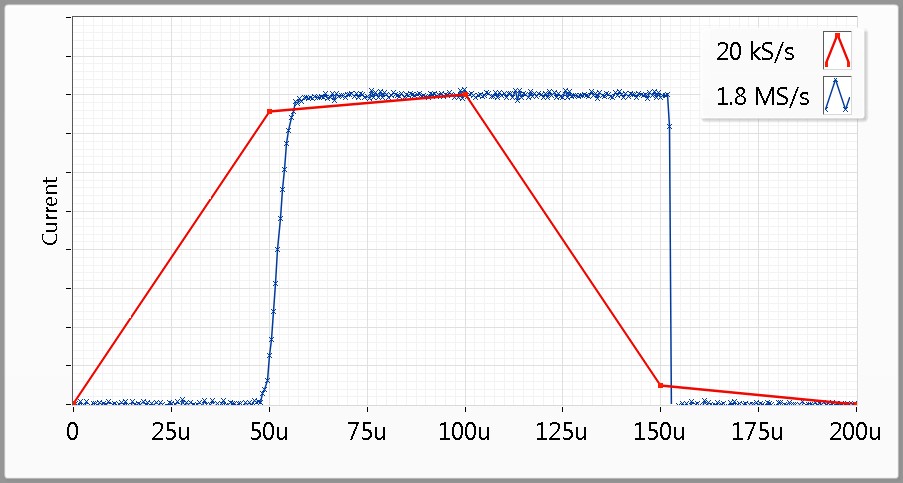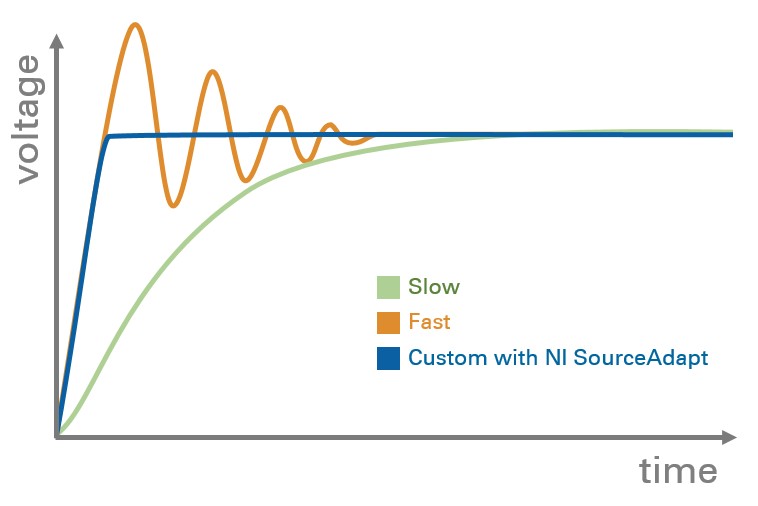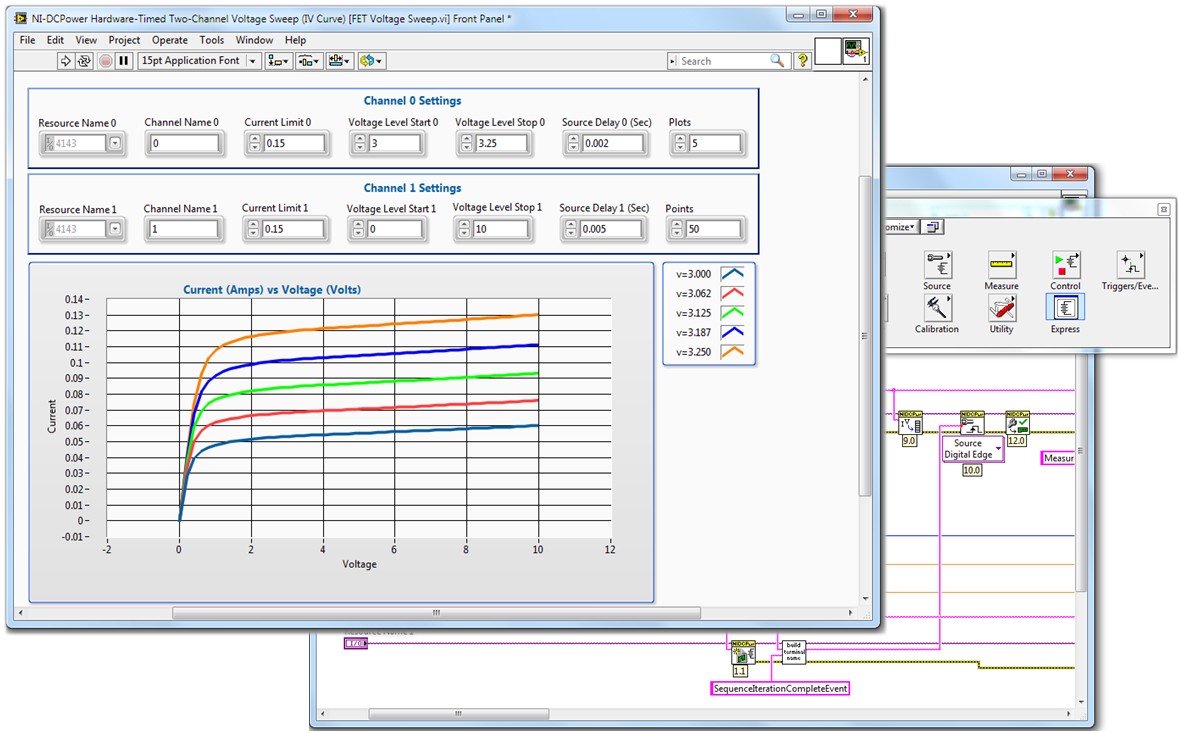Test Smarter with NI PXI Source Measure Units
Overview
National Instruments offers a wide range of source measure units (SMUs) for automated test and lab characterization applications. These SMUs combine the power and measurement performance of traditional box SMUs with NI technology that makes them smaller, faster, and more flexible. The compact form factor and modularity of NI SMUs makes these instruments critical for parallel IV test systems, where you can create high-channel-count solutions with up to 68 channels in a 19 inch, 4U rack space. The modular PXI platform also gives you the ability to trigger these SMUs over the PXI backplane to synchronize measurements with other instrumentation including high-speed digital I/O, RF analyzers and generators, and high-speed digitizers.
Contents
- Broad Range of Hardware Options
- Channel Density
- High-Speed Source and Measure Capability
- Customizable Transient Response—NI SourceAdapt Technology
- Software Benefits
- Take the Next Step
- Next Steps
Broad Range of Hardware Options
NI offers a variety of SMUs in the PXI form factor. These modules serve a wide range of test and characterization needs, from providing power in general-purpose automated test applications to performing parametric tests on semiconductor devices. The following tables show the SMUs from NI.
System SMUs
System SMUs are designed to cover a broad range of applications by providing high-power, high-precision, and high-speed source-measure capability on a single SMU channel. These instruments provide 20 W of continuous DC power and up to 500 W of instantaneous pulsing power.
| PXIe-4135 | PXIe-4137 | PXIe-4139 | |
| Description | Low Current System SMU | Precision System SMU | Precision System SMU |
| Max Voltage | ±200 V | ±200 V | ±60 V |
| Max Current | ±1 A, DC; ±3 A, Pulse | ±1 A, DC; ±3 A, Pulse | ±3 A, DC; ±10 A, Pulse |
| Max Power | 20 W, DC; 480 W, Pulse | 20 W, DC; 480 W, Pulse | 20 W, DC; 500 W, Pulse |
| Max Sampling Rate | 1.8 MS/s | 1.8 MS/s | 1.8 MS/s |
| Max Update Rate | 100 kS/s | 100 kS/s | 100 kS/s |
| Current Sensitivity | 10 fA | 100 fA | 100 fA |
| Timing/Triggering | Hardware-Timed | Hardware-Timed | Hardware-Timed |
| Transient Response | Slow, Normal, Fast, Custom (SourceAdapt) | Slow, Normal, Fast, Custom (SourceAdapt) | Slow, Normal, Fast, Custom (SourceAdapt) |
| View Full Specifications | View Full Specifications | View Full Specifications |
Table 1. System SMUs provide high-power, high-precision, and high-speed source-measure capability on a single SMU channel.
High-Channel-Count SMUs
For high-channel-count, low-power applications, the NI PXIe-414x family of 4-channel SMUs provide industry-leading channel density with up to 68 channels in a single 4U PXI chassis. Due to the customizable transient response, precision, and density, these instruments are ideal for precision semiconductor applications such as MEMS system testing, opens-shorts testing, or powering RF integrated circuits.
| PXIe-4141 | PXIe-4143 | PXIe-4145 | |
| Description | 4-Channel SMU | 4-Channel SMU | 4-Channel SMU |
| Max Voltage | ±10 V | ±24 V | ±6 V |
| Max Current | ±100 mA | ±150 mA | ±500 mA |
| Max Power | 1 W | 3.6 W | 3 W |
| Max Sampling Rate | 600 kS/s | 600 kS/s | 600 kS/s |
| Max Update Rate | 100 kS/s | 100 kS/s | 100 kS/s |
| Current Sensitivity | 10 pA | 10 pA | 15 pA |
| Timing/Triggering | Hardware-Timed | Hardware-Timed | Hardware-Timed |
| Transient Response | Slow, Normal, Fast, Custom (SourceAdapt) | Slow, Normal, Fast, Custom (Sourced) | Slow, Normal, Fast, Custom (SourceAdapt) |
| View Full Specifications | View Full Specifications | View Full Specifications |
Table 2. The NI PXIe-414x family provides industry-leading channel density with up to 68 channels in a single 4U PXI chassis.
Channel Density
NI SMUs provide higher channel density than traditional box SMUs, with up to either 17 or 68 SMU channels in a single 4U rack space as in Figure 1. The compact form factor of NI SMUs makes them ideal for building high-pin-count semiconductor test systems or tightly integrated mixed-signal test systems. For example, you could use only the NI PXIe-4139 system SMU to build a parallel IV test system for high-brightness LEDs, or pair the SMU with other PXI-based instrumentation to build integrated test systems for RF power amplifiers within a single PXI chassis.
Figure 1. Combine up to 17 PXI SMUs channels in a single 18-slot PXI chassis.
Building these high-density or mixed-signal test systems is more challenging with box instruments than a modular platform, both from a density and integration standpoint. Traditional box instruments provide eight SMU channels in the same 4U rack space as a single PXI chassis, compared to 17 channels for an NI SMU with a similar power boundary. The PXI platform also simplifies integration between multiple SMUs and other instrumentals by sharing timing and synchronization triggers within the PXI chassis. Combining this integrated trigger routing with the onboard hardware sequencing engine of NI SMUs, you can easily share events and triggers across multiple SMUs or other instruments without any external wiring.
High-Speed Source and Measure Capability
PXI Express–based SMUs from NI give you the flexibility to perform both high-speed and high-precision DC measurements by varying the measurement aperture time. A short measurement aperture gives you the ability to use the SMU as a digitizer and sample up to 1.8 MS/s, while an extended measurement aperture gives you the ability to take high-precision measurements with up to 10 fA of current resolution.
Precision
NI SMUs can perform high-precision measurements with current sensitivity down to 10 femptoamps (fA). High-precision measurements require an aperture time that gives the SMU analog-to-digital converter sufficient time to integrate the signal and apply noise-rejection filters. The SMU aperture time is often specified in number of power line cycles (NPLCs), and usually defaults to 1 NPLC to filter out power-line induced noise (60 Hz or 50 Hz).
NI SMUs provide the benefit of low noise measurement performance over a range of aperture times, even at high speeds. The graph below compares the measurement performance between the NI PXIe-4139 system SMU and a traditional box SMU, with both instruments having a 100 fA current sensitivity specification. As the aperture time (NPLC) is increased, the SMU integrates the signal for a longer period of time and reduces the noise through techniques such as averaging and filtering.
Figure 2. Current Measurement Noise (amps) As a Function of Aperture Time (NPLC)
(Refer to the numbered list below for details.)
The data captures the RMS current noise of the two SMUs across various aperture times (0.001, 0.01, 0.1, 1, and 2 NPLCs), using the same 1 A current measurement range. Both instruments were calibrated at the same interval and maintained the same test parameters. The following two scenarios show how NI SMUs’ measurement quality and speed compare to a traditional box SMU.
- Comparing the noise performance at the same measurement aperture
The NI SMU provides between 0.1 to 0.2 μA of noise at 1 NPLC, compared to 10 to 20 μA of measurement noise on the box SMU. This represents about a 100X reduction of noise at the same speed, providing better measurement resolution within the same current range.
- Comparing the measurement speed at the same current noise
With traditional box SMUs, you may need an extended aperture time to meet the noise requirements of your measurement. However, the NI SMU achieves the same amount of noise at 0.005 NPLC as the traditional box SMU achieves at a full 1 NPLC, representing over a 100X improvement in speed. This gives you the ability to maintain the same measurement performance while dramatically reducing the overall test time.
High Speed Sampling and Streaming
NI SMUs have a much higher sampling rate than traditional box SMUs, giving you the ability to use the SMU as a high voltage or current digitizer. Additionally, with fast update rates and a customizable SMU response, NI SMUs give you the ability to step through large sequences very quickly or use the SMU to generate arbitrary waveforms. Direct DMA streaming between the host PC and SMU removes the data transfer bottlenecks associated with traditional bus interfaces such as GPIB and Ethernet, and ensures you can stream large waveforms at the full update rate of the SMU. The table below shows how specific NI SMUs compare to a traditional box SMU.
| NI PXIe-4141/3/5 SMU | PXIe-4135/7/9 SMU | Traditional Box SMU | |
| Max Sampling Rate | 600 kS/s | 1.8 MS/s | 20 kS/s |
| Max Update Rate | 100 kS/s | 100 kS/s | 7 kS/s |
| Transient Response | Slow, Normal, Fast, Custom (SourceAdapt) | Slow, Normal, Fast, Custom (SourceAdapt) | Normal, High-Capacitance |
Table 4. Compare the sampling rate, update rate, and transient response settings for NI SMUs to a traditional box.
This digitizer functionality of NI SMUs is essential for capturing detailed transient characteristics of the SMU response or for characterizing device under test (DUT) behavior such as line and load transients. Without this functionality, you would need an external oscilloscope.
Figure 3. NI SMUs provide higher sampling rates than traditional box SMUs.
The figure above shows an SMU generating a current pulse and sampling the output at 20 kS/s and 1.8 MS/s. The 1.8 MS/s sampling rate of the NI SMU gives you the ability to see the detailed transient characteristics of the pulse, and ensure the response has no overshoots or oscillations.
Customizable Transient Response—NI SourceAdapt Technology
SourceAdapt technology gives you the ability to optimize the SMU response for any load—even highly inductive or highly capacitive loads. This next-generation SMU technology implements a digital control loop instead of a traditional analog control loop, so you can completely customize the transient response of the SMU.
Limitations of Traditional SMUs
SMUs use closed-loop feedback control to ensure that the programmed source value (setpoint) is correctly applied to the load under test. Traditional SMUs have used analog hardware to implement the control loop, but this comes with trade-offs. For example, a high-bandwidth SMU designed for high-speed testing is typically not suitable for testing highly capacitive loads that require high stability. On the other hand, an SMU designed to test high-capacitive loads is not likely to be the best option for high-speed testing. In fact, most traditional SMUs are optimized for either high-speed or high-stability test. Even then, it is difficult to achieve an optimal response because it is extremely difficult to design circuitry that provides just the right response for a range of loads.
Benefits of SourceAdapt
SourceAdapt technology fundamentally addresses this issue by helping you custom tune the SMU response to a given load. This provides an optimal SMU response with minimal settling times, which leads to shorter wait times and faster test times, and it eliminates overshoots and oscillations to protect your DUT and ensure system stability. Because tuning the SMU response is done programmatically, an SMU configured for a high-speed test can be easily reconfigured for a high-stability test—maximizing the return on investment of the test equipment and achieving better results.
Figure 4. SourceAdapt technology enables customized responses for
maximum stability and minimum rise times.
Software Benefits
NI-DCPower, an IVI-compliant instrument driver, provides a soft front panel, set of example programs, and a comprehensive API for environments such as NI LabVIEW, NI LabWindows™/CVI, and NI Measurement Studio. The instrument soft front panel is ideal for making single-point IV measurements or for continuously sourcing power to your device. Built-in examples provide out-of-the-box programs for sequencing the output of one or two SMU channels and graphing the response. These example programs demonstrate concepts ranging from simple source-measure configuration to advanced sweeping and IV characterization of semiconductor components. Examples often serve as building blocks for larger or more customized projects in LabVIEW software or test sequences in NI TestStand.
Figure 5. An Example Program for Transistor Characterization With a Modified User Interface
NI SMUs are optimized for programming environments such as LabVIEW, LabWindows/CVI, and Measurement Studio. The tight integration in both development and testing ensure that NI SMUs provide a superior user experience to traditional third-party box instruments. Users can use the full functionality of NI SMUs through a single programming language instead of mixing a variety of Standard Commands for Programmable Instruments (SCPI), LabVIEW VIs, and/or scripting languages. The following list details some of the software features of NI SMUs:
- Built-in measurement palettes
- Example programs
- Detailed, integrated LabVIEW Help
- Thorough error handling and messaging
- Transparent data streaming from the SMU to the host
Take the Next Step
NI SMUs are designed to address a variety of lab characterization and automated test applications by providing a wide range of hardware options along with flexible software. NI SMUs provide the measurement quality of traditional box SMUs in a compact form factor, giving you the ability to build high-channel-count systems with up to 68 channels in a single PXI chassis. Technology like SourceAdapt ensures your SMU generates a fast and stable response for any load, ranging from purely resistive to highly capacitive.
Next Steps
- View the expansive portfolio of PXI SMUs and compare specifications or features
- Consider purchasing the PXIe-4137 or PXIe-4139 as part of the PXI SMU Bundle
- Configure a PXI system today through an online advisor
- Learn more about PXI SMUs
*The mark LabWindows is used under a license from Microsoft Corporation. Windows is a registered trademark of Microsoft Corporation in the United States and other countries.

